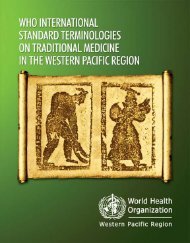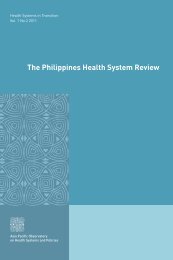Building capacity for NCD prevention and control meeting
Building capacity for NCD prevention and control meeting
Building capacity for NCD prevention and control meeting
Create successful ePaper yourself
Turn your PDF publications into a flip-book with our unique Google optimized e-Paper software.
40<br />
REPORT: A Review REGIONAL of the Japan-WHO MEETING International ON PREVENTION Visitors AND Programme CONTROL on OF <strong>NCD</strong> Prevention <strong>and</strong> Control, 2005-2009<br />
Part Part 12<br />
Background<br />
<strong>Building</strong> Capacity <strong>for</strong> <strong>NCD</strong> Prevention <strong>and</strong> Control<br />
Today,<br />
noncommunicable<br />
diseases (<strong>NCD</strong>)<br />
cause more death<br />
<strong>and</strong> disability in<br />
the Western Pacifi c<br />
than any other<br />
health problem.<br />
Noncommunicable diseases (<strong>NCD</strong>) represent a critical challenge to<br />
public health <strong>and</strong> development in the Western Pacifi c.<br />
Estimates indicate that over three-fourths of deaths in the region<br />
are attributable to <strong>NCD</strong>, compared to 14% of deaths caused by<br />
communicable diseases. i Currently, about 26,500 people die every<br />
day from noncommunicable diseases in the Region, with over 20,000<br />
of these deaths occurring in the Region’s developing countries. II<br />
Noncommunicable diseases, notably heart problems, cancer, stroke<br />
<strong>and</strong> chronic obstructive pulmonary diseases (COPD), account <strong>for</strong> almost<br />
8 out of every 10 deaths in the Western Pacifi c RegionIII .<br />
Moreover, <strong>NCD</strong> represent 92% of the burden of disease in disability-adjusted life years (DALYs) in Western<br />
Pacific Region-A nations (WPR-A: Australia, Brunei Darussalam, Japan, New Zeal<strong>and</strong>, Singapore) <strong>and</strong><br />
approximately 63% in Western Pacifi c Region-B nations (WPR-B: Cambodia, China, Cook Isl<strong>and</strong>s, Fiji, Kiribati,<br />
the Lao People’s Democratic Republic, Malaysia, Marshall Isl<strong>and</strong>s, Micronesia, Mongolia, Nauru, Niue,<br />
Palau, Papua New Guinea, Philippines, Republic of Korea, Samoa, Solomon Isl<strong>and</strong>s, Tonga, Tuvalu, Vanuatu,<br />
Viet Nam.). Moreover, WPR-B nations have more than a quarter of the global total burden of disease in DALYs<br />
<strong>for</strong> malignant neoplasms, <strong>and</strong> close to a third of the global total in respiratory disorders. WPR-B nations also<br />
have a fi fth of the global total burden of disease in DALYs <strong>for</strong> diabetes <strong>and</strong> cardiovascular disease. IV<br />
Globalization <strong>and</strong> urbanization serve as conduits <strong>for</strong> the promotion of unhealthy lifestyles (e.g. tobacco <strong>and</strong><br />
alcohol use, unhealthy diets, <strong>and</strong> physical inactivity) <strong>and</strong> environmental changes (e.g. indoor <strong>and</strong> outdoor<br />
air pollution) that underlie noncommunicable diseases. Ironically, every one of the risk factors <strong>for</strong> <strong>NCD</strong>, with<br />
the exception of age <strong>and</strong> heredity, is preventable. In addition, the evidence base <strong>for</strong> eff ective interventions<br />
is growing. Yet, the prevalence of these risk factors in the Western Pacifi c Region remains unacceptably high,<br />
<strong>and</strong>, in many countries, continues to increase.<br />
The health care costs related to noncommunicable diseases are signifi cant. On top of the direct health care<br />
costs, the economic impact of early death <strong>and</strong> disability, <strong>and</strong> lost productivity due to noncommunicable<br />
diseases contribute to the Region’s burden of poverty, can retard national development <strong>and</strong> can further<br />
widen the health inequities within <strong>and</strong> across countries.<br />
At the global level, WHO Member States adopted a global strategy in 2000 <strong>for</strong> the <strong>prevention</strong> <strong>and</strong> <strong>control</strong><br />
of noncommunicable diseases during the Fifty-third World Health Assembly. The Global Strategy on Diet,<br />
Physical Activity <strong>and</strong> Health was endorsed in 2002. In 2003, the WHO Framework Convention on Tobacco<br />
Control, developed from 1999 to 2003, was ready <strong>for</strong> signature by Member States. The treaty came into <strong>for</strong>ce

















